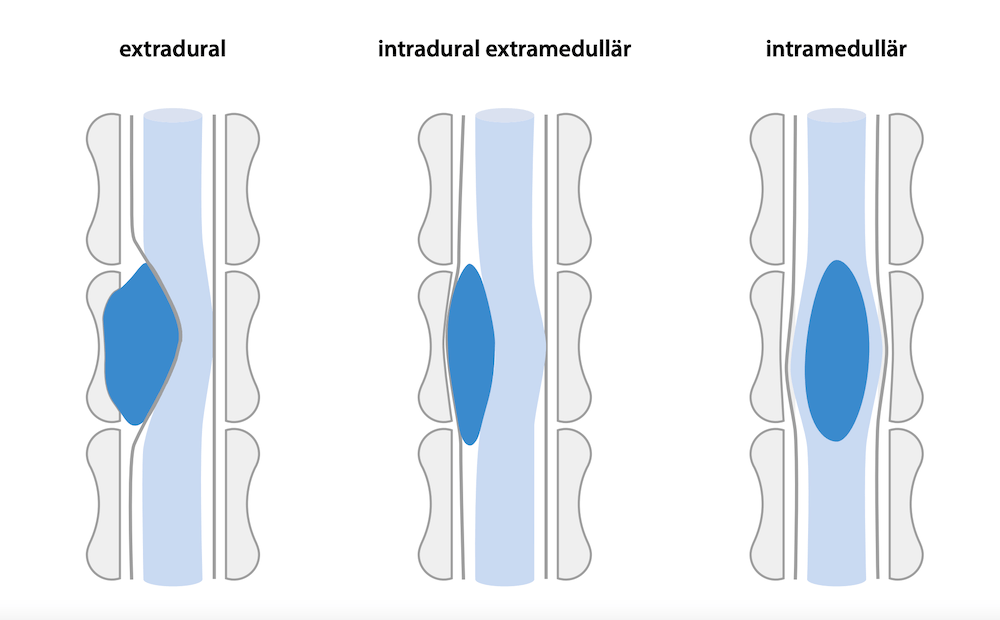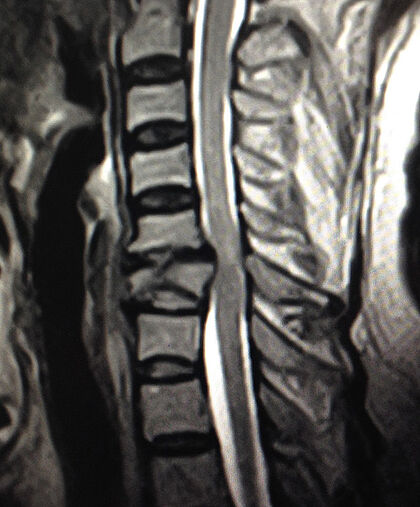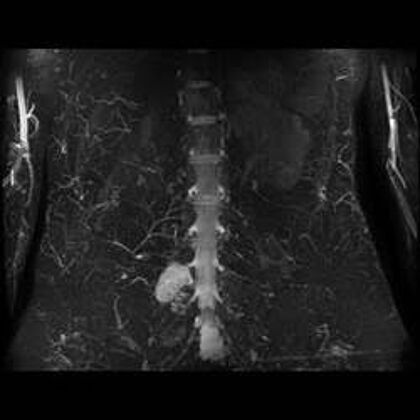Definition - Tumor of the spine
Tumors can occur throughout the body, including as spinal tumors in or on the spinal column. The spinal canal is particularly affected. The corresponding diagnosis of tumor in the spine is not immediately synonymous with cancer. We first refer to all growths and tumors as tumors. Only then is a basic distinction made between benign tumors (meningiomas, neurinomas), malignant tumors and metastases. In an individual and detailed examination, we clarify which type is present and initiate appropriate treatment steps.
The three types of spinal tumors
A tumor on the spine is divided into three categories based on its anatomical location to the spinal cord:
- Extradural tumors
- Intradural-extramedullary tumors
- Intradural-intermedullary tumors
Extradural tumors are located outside the spinal cord membranes. They account for 90% of spinal cord tumors. Tumors that lie within the spinal meninges but outside the spinal cord account for 9%. These are the so-called intradural-extramedullary tumors. Very rarely, at 1 percent, a tumor occurs that lies directly in the spinal cord and thus, of course, in the spinal cord skin. In this case we speak of intradural-intermedullary tumors.
Frequency and types of bone metastases
Metastases are metastases of tumors from other parts of the body. The spine is the most common site for skeletal metastases. Spinal metastases are distributed anatomically as follows:
- 70% thoracic spine
- 20% lumbar spine
- 10% cervical spine
Primary spinal tumors are rare: Only about 5% of all primary skeletal tumors are found in the spine.
Malignant metastases to the spine are mostly metastases from breast cancer (mammary carcinoma), prostate cancer (prostate carcinoma), lung cancer (bronchial carcinoma), kidney cancer or lymph node cancer (lymphoma).
Metastases to the bones, known as bone metastases, are in fact unfortunately very common. After the liver and lungs, the bone is the third most common site of metastasis. Two-thirds of all bone metastases involve the spine. Men are more commonly affected by bone metastases than women: The ratio of men to women is 3:2. Bone metastases occur more frequently with increasing age.
Causes of tumors of the spine
How do metastases get to the spine? Where are the causes of tumors of the spine? Do they form directly on the spine? How exactly do spinal metastases form? To understand cancer, it is helpful to understand what happens when cells undergo cancerous changes.
The body is made up of many different types of cells. Normally, cells grow or divide only when necessary. This regeneration of cells is regulated and serves to keep the body healthy.
If cell division occurs when no new cells are needed, excessive tissue formation occurs. The excess tissue forms a growth called a tumor. The resulting excess tissue can be benign or malignant.
Malignant tumors (carcinomas) mean cancer! It is very common for cancer cells to detach from a malignant primary tumor and invade the bloodstream or lymphatic system. In this way, cancer cells spread from the original tumor (primary tumor) and form new tumors in other organs. Thus, they leave the tumor and travel throughout the body until they find a new place to grow. These colonies, called metastases, are considered the greatest danger in cancer.
The colonies of metastases are usually different from the original tumor. This makes treatment much more difficult. Metastases are responsible for nearly 90% of deaths in cancer patients.
If doctors could prevent new colonies from forming, cancer would also lose much of its terror. But there is unlikely to be a simple solution. That's because, so far, research has mainly shown how complex and multi-layered the development of metastases is. A quick operation or surgical procedure is not enough to treat the spinal metastases.
Pain and neurological disorders in spinal tumors
Unfortunately, there are not the classic specific symptoms by which one can recognize a spinal tumor. Regardless of benignity or malignancy, the growths often constrict the space of the nerve fibers and exert pressure on them.
Benign tumors usually grow slowly and are often an incidental finding during an examination. A benign tumor may also destroy structures and may cause the following symptoms:
- Pain in the periosteum
- Local pressure or knocking pain
- Pain at rest without exertion
- Constant pain
- Painful restriction of movement of the spine
- Neurological disturbances up to disturbances of the bladder and rectum function
- Instability of the spine
In addition to the symptoms caused by the tumor's space-occupying lesion, malignant tumors may cause additional symptoms:
- Fever
- Enlargement of lymph nodes
- Weight loss
- Night sweats
- Fatigue
Basically, one should know: Symptoms depend on the type of tumor and the stage of the disease. In any case, the following applies: pain in the area of the spine that has no explainable origin and does not show spontaneous improvement after a week belongs in the hands of a specialist. After all, pain is the most common symptom in 95 percent of all patients. Motor and autonomic functional limitations are the second most common symptom (in 85 percent of patients).
Diagnosis - this is how tumors are classified
An internationally standardized system, the grading system (TNM), ensures consistent classification of the tumor according to size, lymph node involvement and possible metastases. This classification is the basis for an optimally successful treatment strategy.
The detailed diagnosis of a possible tumor begins with anamnesis (questioning of the patient) and neurological examinations. This is followed by ultrasound, computer tomography (CT), magnetic resonance imaging (MRI) and nuclear medicine examination procedures, as required. Myelography, angiography, biopsy (removal of a tissue sample) and laboratory diagnostics are further important diagnostics in order to initiate an individual therapy and to guarantee the highest quality of treatment. Blood tests, however, are only helpful in the diagnosis in exceptional cases. They are mainly used to exclude other diseases or to detect possible relapses during follow-up care.
The differential diagnosis of tumors of the spine is particularly difficult if a vertebral fracture has occurred. In case of doubt, this can be caused by infections, traumatic or also by various diseases with subsequent bone poverty (osteopenia). Furthermore, imaging diagnostics often provide only limited information about the origin of the tumor and whether it is benign or malignant. Therefore, in case of doubt, it is always necessary to take a sample from the tumor to determine the further therapy.
Therapy depends on the type, location and size of the tumor
When tumors are treated, many patients immediately start to see a film in their mind's eye: Chemotherapy, radiation, surgery. However, the treatment of spinal tumors does not necessarily involve radiation therapy.
Conservative therapy is only of limited use for spinal tumors. The general condition, age, tumor type and tumor size play a role. In the case of older age and small tumors that do not cause any symptoms, it is also possible to wait. Regular follow-up examinations can be used to assess tumor growth and decide when surgery is advisable.
On the whole, however, even a benign spinal tumor should be removed, since its mass can affect neighboring areas and constrict nerves or other sensitive structures. Since tumors are not a clearly delineated clinical picture, they usually require interdisciplinary treatment by physicians from different specialties. Depending on the type, location and size of the tumor, different surgical removal is necessary.
The anatomy of the spinal column with its sensitive spinal cord and spinal nerves set limits to the radical removal of a tumor. If the tumor is in an unfavorable position, it can only be partially removed. However, surgery always improves the quality of life of the patient by reducing the tumor mass.
With the help of microsurgery, benign tumors can usually be removed permanently, especially if they are discovered at an early stage. If there is concomitant destruction of the vertebral joints and vertebral bodies, further procedures such as spondylodesis are used to restore stability. This involves the use of a spinal fixation system consisting of screws and rods. In recent years, gentle ("percutaneous") interventions from behind have been developed to allow rapid rehabilitation and mobilization of the patient in cases of tumor-related instability. If it is necessary to remove the vertebral body and replace it with an "artificial vertebral body" made of titanium, the most modern surgical options are available here as well, using thoracoscopy and keyhole access to the abdomen. This reduces discomfort after surgery and allows a faster resumption of daily life.
While benign tumors of the posterior parts of the spine sometimes only require surgical removal (e.g., osteoblastoma), metastases involving several vertebral bodies often require subsequent radiation therapy or chemotherapy.
The goal of any tumor therapy is to increase the quality of life, i.e., to maintain mobility, reduce pain and prevent neurological deficits, but without losing sight of the overall course of the disease in individual cases.
Prognosis on tumors of the spine
Regular follow-up of tumors of the spine is absolutely necessary. Regular check-ups at six-monthly, and later annually, intervals ensure the stability and healing success of the patient and enable rapid intervention in the event of renewed tumor growth, if necessary by means of a new surgical procedure.
The prognosis of benign tumors is usually good if the diagnosis is made in time and the tumor is removed quickly by surgery, so that the patient is likely to be cured and life expectancy is normal.
In the case of metastases or malignant tumors of the spine, the prognosis depends on many factors - such as age, general condition, number and localization of metastases, and degree of malignancy.
The Avicenna Clinic in Berlin is always willing to help you
Since the year 2001, the Avicenna Clinic is based in Berlin. Our doctors have at least 25 years of international experience in their respective fields (neurosurgery, spinal surgery, anesthesia, and orthopedics).
If you have severe back pain, a herniated disc or a suspected herniation, please contact us using the following information:




